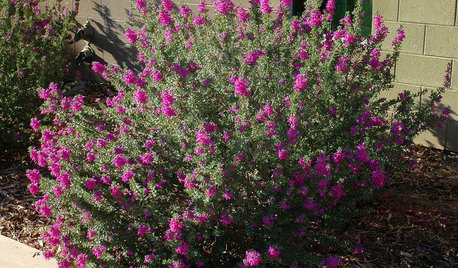Merry Heart,
Just because you and I think it sounds like cotton root rot is present in your soil doesn't necessarily mean that it is. However, I think there is a good chance we are right.
You could check with the Noble Foundation. I'm sure that they've done research in the area. At the time I was having plant problems, I was new here and didn't know much about the foundation back them. You also could check with your county's ag extension agent and with OSU. I am sure there must be a test they can do for the presence of cotton root rot, but I am not positive about that. With some pathogens, the best test is to send the roots and surrounding soil to a university testing lab for a diagnosis. But I am of the old school of thought that says if it walks like a duck and talks like a duck, it probably is a duck, even without a lab diagnosis to verify it.
So, assuming it is cotton root rot, there are some things you can do.
1. You can plant any kind of plants that are monocotyledonous, like grasses. There are many lovely ornamental grasses.
2. You can work to lower the pH of your soil. This is hard work and can be costly. It also is never-ending because the pH of the water and native soil will overcome a lot of your efforts to lower the pH. Applying fertilizers that are high in nitrogen seems to help. So does applying greensand. For each 100 square feet of soil, work 1 pound of ammonium nitrate into the soil. You can also add sulfur to the soil. Some people have been able to use ammonium nitrate and sulfur to save plants with cotton root rot if they figure out what the disease is in time to treat the soil. However, the soil treatments must continue annually and are no guarantee the root rot will not eventually win any way.
3. You can plant stuff that has show resistance or tolerance to cotton root rot. There are lots of resistant and tolerant plants. Keep in mind though that resistance is only resistance and not immunity. Tolerance means there is some tolerance, but not resistance. There are no plants that are guaranteed NEVER to be susceptible to cotton root rot as far as I know, but many of these resistant and tolerant plants have excellent resistance to it or tolerance of it.
LARGE SHADE TREES WITH RESISTANCE OR TOLERANCE:
Pecan
Hickory
Sycamore
Cedar Elm
Honey Mesquite
Easter Red Cedar (wouldn't you just know it!)
Hackberry
All of the above grow on our property with wild abandon, so I'm betting they have superior resistance to CRR. The ones listed below are on lists of CRR resistant or tolerant plants but I haven't grown them.
Japanese Pagoda Tree (Sophora japnica)
Live Oak (Quercus virginiana)
Japanese Black Pine (Pinus densiflora)
Osage Orange/Bois D'Arc (Maclura pomifera)
Atlas Cedar (Cedrus atlantica)
Deodara cedar (Cedrus deodora)
Eleagnus/Russian Olive (Eleagnus angustifolia)
Kentucky Coffee Tree (Gymnocladus dioicus)--grows wild along the fence lines around us, but we don't have it on our property
American Holly (Ilex opaca)
ORNAMENTAL SMALL TREES/LARGE SHRUBS WITH TOLERANCE OR RESISTANCE:
Mexican Plum (Prunus mexican)
Possom Haw Holly (Ilex decidua)
Texas Persimmon (Diospyros texana)
All three of the above are native on our property.
OTHERS ON THE LIST (I haven't tried any of these myself):
Japanese Holly (Ilex Crenata)
Yaupon Holly (Ilex vomitoria) I have planted these. Some
lived and some died, but I'm not sure if CRR was involved.
Pomegranate (Punica granatum) is a zone 8 plant, may not survive our winters
Texas Mountain Laurel (Sophora secudiflora) is a zone 8 plant, may not survive our winters
MEDIUM TO SMALL SIZED SHRUBS WITH TOLERANCE OR RESISTANCE:
American Beautyberry (Callicarpa americana) I have hundreds of these growing as understory plants in our woods.
Indian currant (aka Coralberry) (Symphoricarpos orbiculatus)
These grow as a native groundcover in our woods. I don't think anything can or will kill them.)
Others on the lists that I haven't grown:
Yucca species
Century Plant (Agave americana)
Texas Sotol (Dasylirion texanum) supposed to be a zone 7 plant, but I haven't seen any growing around here
Red Yucca ( Hesperaloe parvilfora) Hummingbirds love it.
Dwarf Yaupon Holly (Ilex vomitoria nana) many hybrid varieties are available
Santolina (Santolina species) I think they need great drainage in order to grow well.
Tatatian honeysuckle (Lonicera tatarica)
Morror honeysuckle (Lonicera morrowi)
Lavender (Lavandula officinalis) Needs perfect drainage.
Pfitzer junipers (Juniperus chinensis pfitzer) many hybrid varieties available
HERBACEOUS OR FLOWERING PLANTS: These have been my salvation. I gave up on trying to plant pretty much anything else in the area where I lost plants to cotton root rot.
Amaranth (Amaranthus hybridus) I grow both the grain types and ornamental flowering types.
FROM BULBS, TUBERS OR RHIZOMES:
Anemone or Windflower (Anemone spp. hybrids)
Lily (Lilium spp.)
Iris (Iris spp.)
Buttercup (Ranuculus spp.)
Gladiolus (Gladiolus spp.)
Freesias (Freesia spp.)
Caladium (Caladium x hortulanum)
Daylily (Hemerocallis spp.)
Canna (Canna spp.)
Tulips (Tulip gesneriana)
Daffodils (Narcissus spp.)
From seed or transplants:
Sweet Alyssum (Lobularia maritima)
Poppy (Papaver orientale)
Larkspur (Delphinium spp.)
Carnation (Dianthus caryophyllus)
Sweet William (Dianthus barbaratus)
Bachelor's Buttons (Centaurea cyanus)
Calendula (Calendula spp.)
Texas Bluebonnets (Lupinus texensis)
Baby Blue Eyes (Nemophilia spp.)
Drummond Phlox and Garden Phlox (Phlox spp.)
Johnny Jump-ups (Viola Tricolor)
Begonias (Wax Begonias)
Coleus (but I've only grown them successfully in the better-draining areas of my garden)
Petunias (Petunia hybrids) However, I do have Mexican petunia (Ruellia spp.)g rowing wild on the edges of my woods, so think it is resistant.
Blue Salvia (Salvia azurea)
Garden Salvia (Salvia officinalis)
Blue-eyed Grass (Sisyrichium spp.) grows native on our land and has little bulblet type roots. Is now sold in some pretty fancy seed catalogs. I have the common everyday native one. Is very pretty and blooms along with the Indian Paintbrush and common yallow to give me a pasture of red, white and blue flowers.
Marigolds (Tagetes spp.)
Nasturtiums (Tropaeolum majus)
Mints (Mentha spp.)
Scarlet Salvia (Salva spendens)
Zinnias (Zinnia elegans and zinnia angustifolia)
I also have tons and tons and tons of native grasses and wildflowers. It is hard to know what is resistant or what is merely shallow rooted and may not get down far enough into the soil to encounter the root rot.
I hope that you don't have the cotton root rot fungus in your soil. However, based on what I went through, Merry Heart, I think that you might. Your story is just so identical to mine. Even if your soil never grew cotton, the root rot can be there.
As I said in the other post, as I was reading your tales of woe of trees that were seemingly well-established and suddenly died, it was deja vu all over again, as Yogi Bera would say.
Having cotton root rot doesn't condemn you to a life without trees. I do think that all the native oaks are resistant to it also, but I believe you said you were seeing decline in a red oak, so I'm a nervous about that one.
In parts of Texas and California as well as a few other states there is a disease called Oak Wilt that is wiping out some species of oaks. I don't think it is related to CRR, but seems to appear suddenly and work much the same way. There is an expensive treatment for oak wilt, but it is hundreds of dollars per tree and results are not guaranteed.
I have always wanted to grow a few cotton plants for fun, but I am assuming it would be impossible for me. All I need to do is to provide the cotton root rot with one more plant to go after! Every year when I get my Southern Seed Exchange catalog, I see the interesting ones they offer and wish I could try them. Just for fun. The flowers are very pretty. Oh, well, sometimes we just have to accept that some plants won't grow for us in our soil or climate conditions.
Dawn














katrina1
Okiedawn OK Zone 7Original Author
Related Discussions
Cotton string for wick?
Q
Phals roots keep rotting!
Q
Help: Is this root rot on my Lavender
Q
Heart broken .....
Q
merryheart
merryheart
katrina1
merryheart
Okiedawn OK Zone 7Original Author
merryheart
merryheart
Okiedawn OK Zone 7Original Author